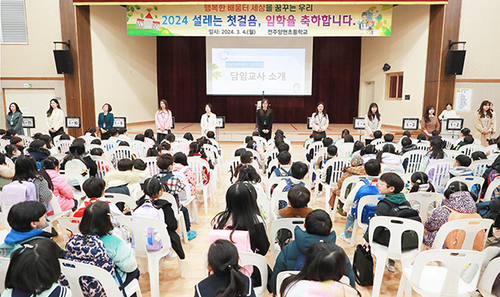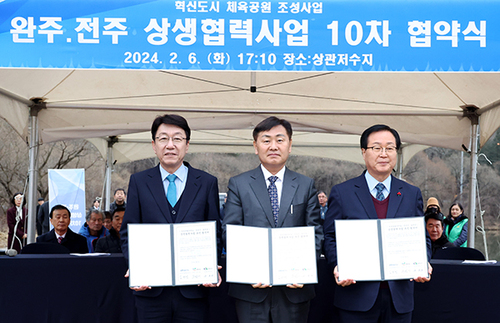| ▲ 전북 고창 봉덕리 고분군 제1호분에 출토된 백제 시대 '금동신발(金銅飾履)'이 국가지정문화재 보물로 21일 지정된 가운데 지금까지 삼국 시대의 고분에서 출토된 금동신발 가운데 가장 완벽한 형태를 보이고 있다. / 사진제공 = 고창군청 © 김현종 기자 |
|
1500년 전 한국 고대인들의 상장례(喪葬禮) 문화를 알려주는 중요한 유물인 고창 봉덕리 1호분에서 출토된 금동신발(金銅飾履)이 국가지정문화재 보물로 지정됐다.
전북 고창군은 "'고창 봉덕리 1호분 출토 금동신발(高敞 鳳德里 一號墳)'과 5∼6세기 금속공예 기술을 엿볼 수 있는 '전남 나주 정촌고분에서 출토된 백제시대 금동신발 2건과 장성 백양사 아미타여래설법도 및 복장유물을 문화재청이 21일 보물로 지정했다"고 밝혔다.
봉덕리 1호분에서 출토된 금동신발은 봉덕리에 자리한 4기의 대형 분구묘(墳丘墓 = 분구를 조성한 다음 그 안에 매장시설을 설치하는 무덤양식) 중 규모가 가장 큰 1호분의 제4호 석실에서 2009년 원광대학교 마한백제문화연구소가 발굴했다.
4호 석실은 전혀 도굴되지 않은 무덤으로 여기에서 금동신발 한 쌍이 무덤 주인공의 양쪽 발에 신겨져 거의 훼손되지 않아 삼국시대 고분에서 출토된 금동신발 가운데 가장 완전한 형태로 발견된 보기 드문 사례다.
그동안 삼국시대 고분에서 출토된 ▲ 귀걸이 ▲ 목걸이 ▲ 팔찌 등은 국보나 보물로 상당수 지정됐지만 금동신발이 국가지정문화재로 지정된 것은 이번이 처음이다.
금동신발은 삼국시대 유적에서만 발견되는 우리 고유의 고대 금속공예품 중 하나로 비슷한 시기 중국 유적에서는 찾아보기 힘들고 일본 고분에서는 유사한 형태의 신발이 출토된 적이 있지만 이는 우리나라에서 전래된 것이다.
2009년 고창 봉덕리 1호분에서 출토된 금동신발의 전체적인 형태는 배 모양이다.
발목 깃을 갖췄고 앞쪽은 뾰족하면서 약간 위로 들렸으며 중간 바닥이 편평하고 뒤쪽은 약간 좁아지면서 둥근 형태다.
또, 투각(透刻 = 재료 면을 도려내거나 깎아서 무늬를 만드는 방식)한 육각형 안에 용ㆍ인면조신(人面鳥身 = 사람얼굴에 새 몸통을 가진 상상의 동물)ㆍ쌍조문(雙鳥文 = 두 마리 새 문양)ㆍ괴수(怪獸)ㆍ연꽃 등 각종 문양을 화려하게 장식했다.
신발 바닥에는 높이 1.7cm의 뾰족한 못 18개를 규칙적으로 붙였으며 내부는 비단 재질의 직물을 발라 마감했다.
이 유물은 백제의 중앙 권력자가 제작해 왕의 힘을 과시하고 지방 수장의 위신을 세워주기 위해 지방 유력 지배층에 내려준 위세품(威勢品)으로 추정된다.
특히 고창 봉덕리 1호분에서 출토된 금동신발은 현재까지 백제시대 고분에서 나온약 19점의 금동신발 가운데 가장 완벽한 형태다.
나주 정촌고분에서 출토된금동신발과비교했을 때 어자무늬(魚子文 = 물고기 알 문양) 등 삼국시대 초기 문양이 확인돼 시기적으로 앞서 제작된 것으로 판단된다.
무령왕릉의 왕과 왕비의 신발과 마찬가지로 바닥판ㆍ좌우측판ㆍ발목깃판으로 구성됐고 바닥에 징(스파이크)을박은 백제 금동신발의 전형적인 특징을 지니고 있다.
또한, 백제시대 의례용 금동신발로보기 드물게 원형을 갖춰 출토된 중요한 고대 금속공예품이자 다양하고 뛰어난 공예기법을 이용해 제작된 것으로 5세기 중반 백제 미술을 대표하는 작품으로 보물로 지정할 가치가 충분하다는 평가를 받았다.
☞ 아래는 위 기사를 구글 번역이 번역한 영문의 '전문'이다.
【Below is the 'full text' of an English article translated from the above article with Google Translate.】
Designated as a treasure of the Three Kingdoms era 'Gold Dong Shoes'
Gochang Bongdeok-ri burial mound no. 1 excavated… First time in the country
Reporter Kim Hyun-jong
The Geumdong Shoes (金銅飾履) excavated from the No. 1 Bongdeok-ri, Gochang, an important relic that informs the culture of the ancient Koreans' Sangjangrye (喪葬禮) 1500 years ago, has been designated as a nationally designated cultural property treasure.
Gochang-gun, Jeonbuk said, "Geumdong shoes excavated from the 1st Bongdeok-ri, Gochang" and "2 Geumdong shoes excavated from Jeongchon tomb in Naju, Jeollanam-do, and Jangseong." On the 21st, the Cultural Heritage Administration designated the Amitabha Nyeoraedo and costume relics of Baekyangsa as a treasure."
The Geumdong shoes excavated from Bongdeok-ri 1 are located in Bongdeok-ri in 2009 in the 4th stone chamber of the 1st block, the largest among the 4 large-scale bungu tombs (墳丘墓 = grave style in which burial facilities are installed after building a bungu). Wonkwang University's Mahan Baekje Culture Research Center discovered it.
Stone Chamber No. 4 is a tomb that has not been stolen. This is a rare case where a pair of gold-dong shoes were worn on both feet of the tomb's protagonist and were barely damaged, so it was found in the most complete form among the gold-dong shoes unearthed from the Three Kingdoms period tombs.
Many of the ▲ earrings, necklaces, and bracelets excavated from the Three Kingdoms period tombs have been designated as national treasures or treasures, but this is the first time that gold-dong shoes have been designated as nationally designated cultural properties.
Geumdong shoes are one of our own ancient metal crafts found only in the ruins of the Three Kingdoms period. It is difficult to find in Chinese ruins at the same time, and shoes of similar types have been excavated in Japanese burial mounds.
The overall shape of the Geumdong shoes unearthed at Bongdeok-ri, Gochang in 2009, is shaped like a boat.
It has ankle collars, and the front is pointed and lifts up slightly, the middle bottom is flat, and the back is rounded with a slight narrowing.
In addition, a dragon and a human face (人面鳥身 = an imaginary animal with a new body on a human face) and Ssangjomun (雙鳥文 = Various patterns such as two birds pattern), monsters, and lotus were decorated in a colorful way.
Eighteen 1.7cm high pointed nails were regularly attached to the bottom of the shoe, and the inside was finished with silk fabric.
It is believed that this relic was created by the central authority of Baekje and handed down to the influential local ruling class to show off the power of the king and to uphold the prestige of the local head.
In particular, the Geumdong shoes excavated from Bongdeok-ri, Gochang, are the most complete form of the 19 pieces of gold-dong shoes from the Baekje era tombs.
Compared to the Geumdong shoes excavated from Jeongchon tomb in Naju, the early patterns of the Three Kingdoms period, such as the eoja pattern (魚子文 = fish egg pattern), were confirmed, and it is believed that they were produced in advance.
Like the shoes of the king and queen of King Muryeong's tomb, it consists of a sole plate, left and right side plate, and ankle plate, and has a typical characteristic of Baekje gold-dong shoes with gongs (spikes) on the floor.
In addition, it is an important ancient metal craft excavated with a rare prototype as a gold-dong shoe for rituals of the Baekje period, and it was produced using a variety of excellent craft techniques. received.





















 많이 본 뉴스
많이 본 뉴스











